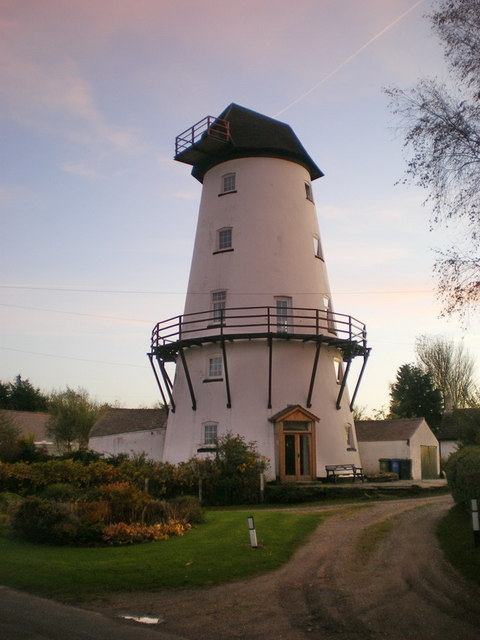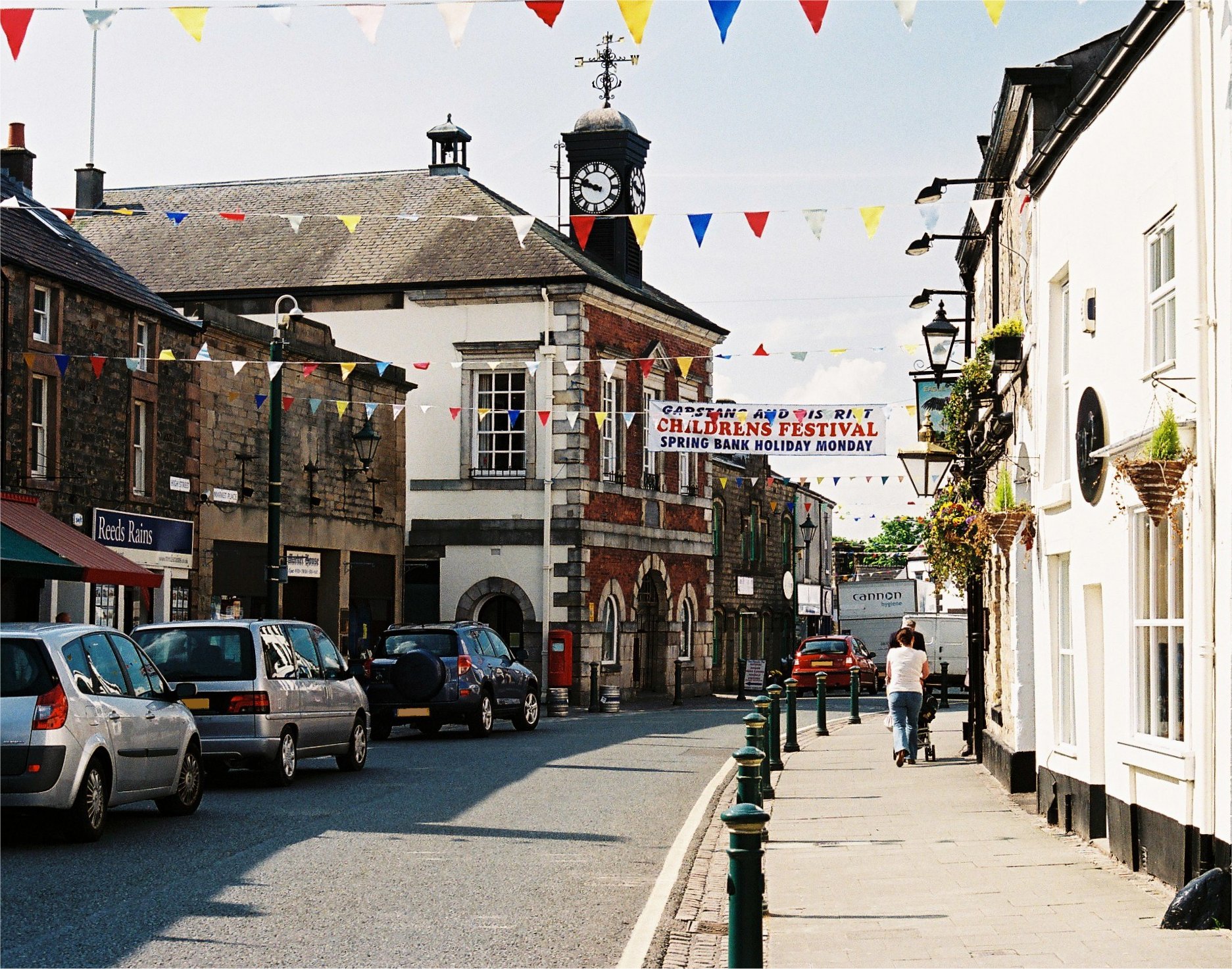|
Old St John The Baptist's Church, Pilling
Old St John the Baptist's Church is a redundant Anglican church in the village of Pilling, Lancashire, England. It stands to the south of the new church, also dedicated to St John the Baptist. The church is "an unusual survival of a small Georgian church". It is recorded in the National Heritage List for England as a designated Grade II* listed building, and it is under the care of the Churches Conservation Trust. History The village was originally served by a small medieval chapel ( by ), serviced until the Dissolution by the canons of Cockersand Abbey. In 1716 the parishioners of Pilling petitioned the Bishop of Chester for a new church. In response, St John's was built in 1717. The only structural alteration since then was the raising of the walls in 1813 to accommodate galleries. It became redundant when the new church was built in 1887. The church was vested in the Trust on 1 August 1986. St John's is termed a chapel, rather than a church, due ... [...More Info...] [...Related Items...] OR: [Wikipedia] [Google] [Baidu] |
Pilling
Pilling is a village and civil parish within the Borough of Wyre, Wyre borough of Lancashire, England. It is north-northeast of Poulton-le-Fylde, south-southwest of Lancaster, Lancashire, Lancaster and northwest of Preston, Lancashire, Preston, in a part of the Fylde known as Over Wyre. The civil parish of Pilling, which includes the localities of Stake Pool, Scronkey and Eagland Hill, had a total resident population of 1,739 in 2001, increasing to 2,020 at the 2011 Census. Populations in the 19th century ranged from 1,281 in 1851 to 1,572 in 1871. Etymology Eilert Ekwall suggests the name is Common Brittonic, Celtic, linking it with the Welsh toponymy, Welsh place-name element Pil (placename), "Pîl" (rendered as Pyl in Old English). This etymology would suggest the settlement started as a tidal inlet used as a harbour. Ekwall suggested the geography of Pilling may be "accurately described as a pill". The name appears as ''Pylin'' in 1246 and, if the name is indeed Celt ... [...More Info...] [...Related Items...] OR: [Wikipedia] [Google] [Baidu] |
Bishop Of Chester
The Bishop of Chester is the Ordinary of the Church of England Diocese of Chester in the Province of York. The diocese extends across most of the historic county boundaries of Cheshire, including the Wirral Peninsula and has its see in the City of Chester where the seat is located at the Cathedral Church of Christ and the Blessed Virgin Mary, which was formerly the Benedictine Abbey of Saint Werburgh, being elevated to cathedral status in 1541. The Bishop's residence is Bishop's House, Chester. Cheshire previously held a bishopric from 1075 when the seat was at the collegiate church of St John the Baptist until 1102. The present diocese was formed in 1541 under King Henry VIII. Mark Tanner's election as Bishop of Chester was confirmed on 15 July 2020.https://www.chester.anglican.org/content/pages/documents/1594794583.pdf Earliest times Chester at various periods in its history had a bishop and a cathedral, though till the early sixteenth century only intermittently. ... [...More Info...] [...Related Items...] OR: [Wikipedia] [Google] [Baidu] |
Mullion
A mullion is a vertical element that forms a division between units of a window or screen, or is used decoratively. It is also often used as a division between double doors. When dividing adjacent window units its primary purpose is a rigid support to the glazing of the window. Its secondary purpose is to provide structural support to an arch or lintel above the window opening. Horizontal elements separating the head of a door from a window above are called transoms. History Stone mullions were used in Armenian, Saxon and Islamic architecture prior to the 10th century. They became a common and fashionable architectural feature across Europe in Romanesque architecture, with paired windows divided by a mullion, set beneath a single arch. The same structural form was used for open arcades as well as windows, and is found in galleries and cloisters. In Gothic architecture windows became larger and arrangements of multiple mullions and openings were used, both for structure and ... [...More Info...] [...Related Items...] OR: [Wikipedia] [Google] [Baidu] |
Bay (architecture)
In architecture, a bay is the space between architectural elements, or a recess or compartment. The term ''bay'' comes from Old French ''baie'', meaning an opening or hole."Bay" ''Online Etymology Dictionary''. http://www.etymonline.com/index.php?allowed_in_frame=0&search=bay&searchmode=none accessed 3/10/2014 __NOTOC__ Examples # The spaces between posts, columns, or buttresses in the length of a building, the division in the widths being called aisles. This meaning also applies to overhead vaults (between ribs), in a building using a vaulted structural system. For example, the Gothic architecture period's Chartres Cathedral has a nave (main interior space) that is '' "seven bays long." '' Similarly in timber framing a bay is the space between posts in the transverse direction of the building and aisles run longitudinally."Bay", n.3. def. 1-6 and "Bay", n.5 def 2. ''Oxford English Dictionary'' Second Edition on CD-ROM (v. 4.0) © Oxford University Press 2009 # Where there a ... [...More Info...] [...Related Items...] OR: [Wikipedia] [Google] [Baidu] |
Bellcote
A bellcote, bell-cote or bell-cot is a small framework and shelter for one or more bells. Bellcotes are most common in church architecture but are also seen on institutions such as schools. The bellcote may be carried on brackets projecting from a wall or built on the roof of chapels or churches that have no towers. The bellcote often holds the Sanctus bell that is rung at the consecration of the Eucharist. The bellcote is mentioned throughout history books when referring to older structures and communities. ''Bromsgrove church: its history and antiquities'' is one example which goes into depth about the construction and maintenance of the bellcoteBellcotes are also discussed in The Wiltshire Archæological and Natural History MagazineVolume 8anProceedings of the Somersetshire Archaeological and Natural ..., Volume 29 Etymology ''Bellcote'' is a compound noun of the words ''bell'' and ''cot'' or ''cote''. Bell#Etymology, ''Bell'' is self-explanatory. The word ''cot'' or ''cot ... [...More Info...] [...Related Items...] OR: [Wikipedia] [Google] [Baidu] |
Gable
A gable is the generally triangular portion of a wall between the edges of intersecting roof pitches. The shape of the gable and how it is detailed depends on the structural system used, which reflects climate, material availability, and aesthetic concerns. The term gable wall or gable end more commonly refers to the entire wall, including the gable and the wall below it. Some types of roof do not have a gable (for example hip roofs do not). One common type of roof with gables, the gable roof, is named after its prominent gables. A parapet made of a series of curves (Dutch gable) or horizontal steps (crow-stepped gable) may hide the diagonal lines of the roof. Gable ends of more recent buildings are often treated in the same way as the Classic pediment form. But unlike Classical structures, which operate through trabeation, the gable ends of many buildings are actually bearing-wall structures. Gable style is also used in the design of fabric structures, with varying degree ... [...More Info...] [...Related Items...] OR: [Wikipedia] [Google] [Baidu] |
Quoin (architecture)
Quoins ( or ) are masonry blocks at the corner of a wall. Some are structural, providing strength for a wall made with inferior stone or rubble, while others merely add aesthetic detail to a corner. According to one 19th century encyclopedia, these imply strength, permanence, and expense, all reinforcing the onlooker's sense of a structure's presence. Stone quoins are used on stone or brick buildings. Brick quoins may appear on brick buildings, extending from the facing brickwork in such a way as to give the appearance of generally uniformly cut ashlar blocks of stone larger than the bricks. Where quoins are decorative and non-load-bearing a wider variety of materials is used, including timber, stucco, or other cement render. Techniques Ashlar blocks In a traditional, often decorative use, large rectangular ashlar stone blocks or replicas are laid horizontally at the corners. This results in an alternate, quoining pattern. Alternate cornerstones Courses of large and small c ... [...More Info...] [...Related Items...] OR: [Wikipedia] [Google] [Baidu] |
Chamfer
A chamfer or is a transitional edge between two faces of an object. Sometimes defined as a form of bevel, it is often created at a 45° angle between two adjoining right-angled faces. Chamfers are frequently used in machining, carpentry, furniture, concrete formwork, mirrors, and to facilitate assembly of many mechanical engineering designs. Terminology In machining the word '' bevel'' is not used to refer to a chamfer. Machinists use chamfers to "ease" otherwise sharp edges, both for safety and to prevent damage to the edges. A ''chamfer'' may sometimes be regarded as a type of bevel, and the terms are often used interchangeably. In furniture-making, a lark's tongue is a chamfer which ends short of a piece in a gradual outward curve, leaving the remainder of the edge as a right angle. Chamfers may be formed in either inside or outside adjoining faces of an object or room. By comparison, a ''fillet'' is the rounding-off of an interior corner, and a ''round'' (or ''radiu ... [...More Info...] [...Related Items...] OR: [Wikipedia] [Google] [Baidu] |
Plinth
A pedestal (from French ''piédestal'', Italian ''piedistallo'' 'foot of a stall') or plinth is a support at the bottom of a statue, vase, column, or certain altars. Smaller pedestals, especially if round in shape, may be called socles. In civil engineering, it is also called ''basement''. The minimum height of the plinth is usually kept as 45 cm (for buildings). It transmits loads from superstructure to the substructure and acts as the retaining wall for the filling inside the plinth or raised floor. In sculpting, the terms base, plinth, and pedestal are defined according to their subtle differences. A base is defined as a large mass that supports the sculpture from below. A plinth is defined as a flat and planar support which separates the sculpture from the environment. A pedestal, on the other hand, is defined as a shaft-like form that raises the sculpture and separates it from the base. An elevated pedestal or plinth that bears a statue, and which is raised from ... [...More Info...] [...Related Items...] OR: [Wikipedia] [Google] [Baidu] |
Sandstone
Sandstone is a clastic sedimentary rock composed mainly of sand-sized (0.0625 to 2 mm) silicate grains. Sandstones comprise about 20–25% of all sedimentary rocks. Most sandstone is composed of quartz or feldspar (both silicates) because they are the most resistant minerals to weathering processes at the Earth's surface. Like uncemented sand, sandstone may be any color due to impurities within the minerals, but the most common colors are tan, brown, yellow, red, grey, pink, white, and black. Since sandstone beds often form highly visible cliffs and other topographic features, certain colors of sandstone have been strongly identified with certain regions. Rock formations that are primarily composed of sandstone usually allow the percolation of water and other fluids and are porous enough to store large quantities, making them valuable aquifers and petroleum reservoirs. Quartz-bearing sandstone can be changed into quartzite through metamorphism, usually related to ... [...More Info...] [...Related Items...] OR: [Wikipedia] [Google] [Baidu] |
Perpetual Curate
Perpetual curate was a class of resident parish priest or incumbent curate within the United Church of England and Ireland (name of the combined Anglican churches of England and Ireland from 1800 to 1871). The term is found in common use mainly during the first half of the 19th century. The legal status of perpetual curate originated as an administrative anomaly in the 16th century. Unlike ancient rectories and vicarages, perpetual curacies were supported by a cash stipend, usually maintained by an endowment fund, and had no ancient right to income from tithe or glebe. In the 19th century, when large numbers of new churches and parochial units were needed in England and Wales politically and administratively, it proved much more acceptable to elevate former chapelries to parish status, or create ecclesiastical districts with new churches within ancient parishes, than to divide existing vicarages and rectories. Under the legislation introduced to facilitate this, the parish priest ... [...More Info...] [...Related Items...] OR: [Wikipedia] [Google] [Baidu] |
Garstang
Garstang is an ancient market town and civil parish within the Wyre borough of Lancashire, England. It is north of the city of Preston and the same distance south of Lancaster. In 2011, the parish had a total resident population of 4,268; the larger Garstang Built-up Area, which includes the adjoining settlements of Bonds and Cabus, had population of 6,779. Garstang is famous for being the world's first ever Fairtrade Town. Etymology Garstang is mentioned in the Domesday Book as ''Cherestanc in 1086''. Later recordings of the name include Geresteng, Gairstang in 1195; Grestein, 1204; Gayrestan, 1236; Gayerstang, 1246; Gayrstang, 1274; Gayrestang, 1292. The original spelling of Garstang has several interpretations: "'gore by the boundary pole", "spear post", "triangular piece of land", "common land" or "meadowland". Possibly signifying the site of a meeting-space. The Old Norse derivation being 'geiri', a gore, from 'geirr', with 'stang' or 'stong', meaning "pole" or "bo ... [...More Info...] [...Related Items...] OR: [Wikipedia] [Google] [Baidu] |



.jpg)
Saunders_Quarry-1.jpg)

